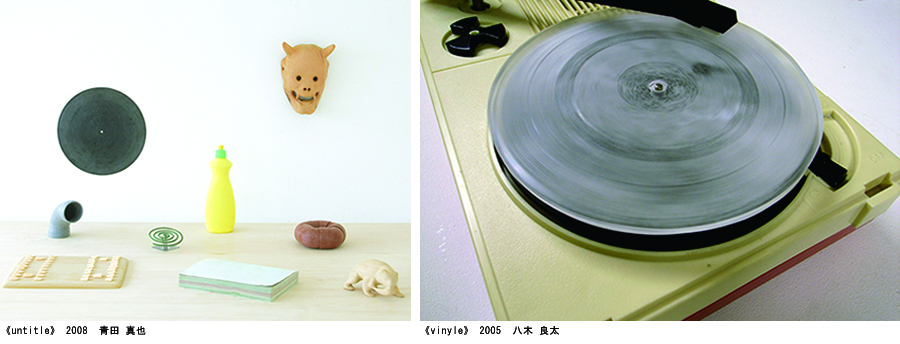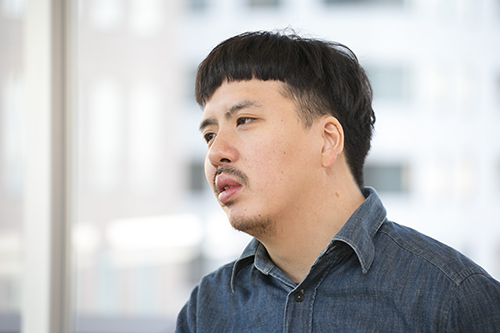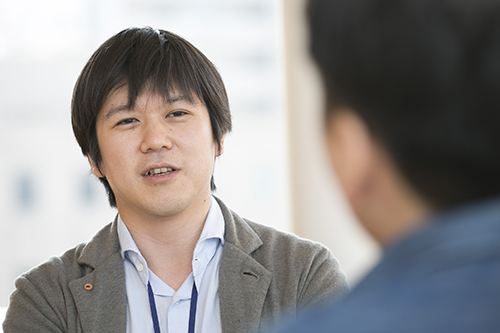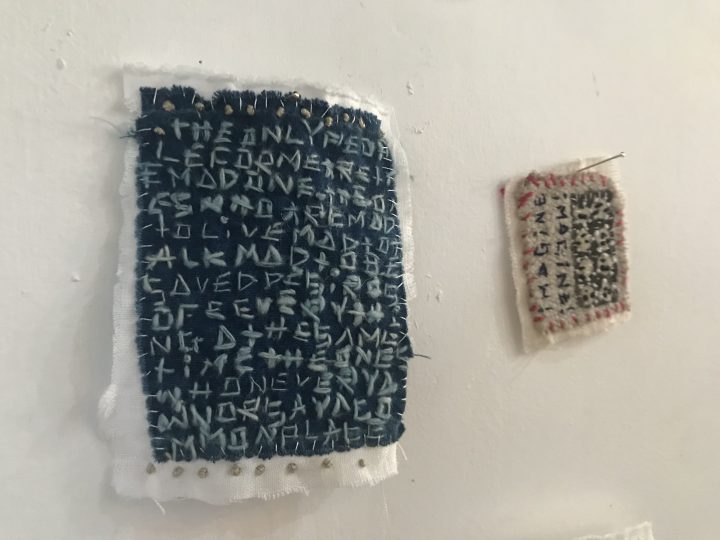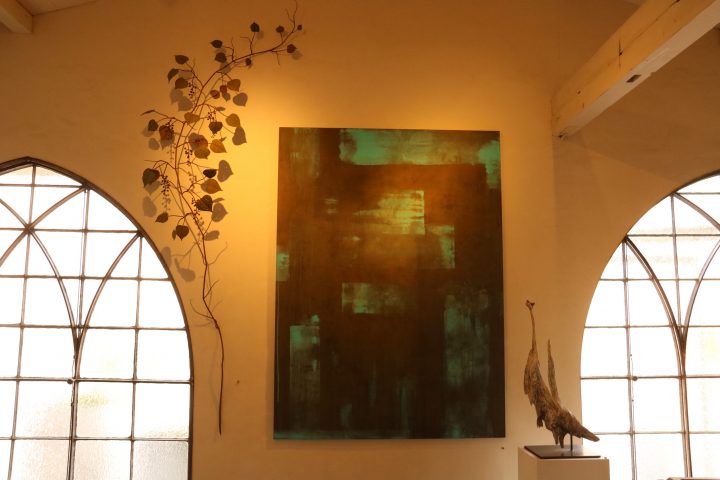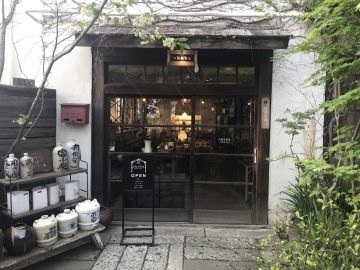[Daily Life/Off the Record Exhibition Linked Project] Cross-Interview with Shinya Aota and Ryota Yagi

Text by : akiko inoue Photography by : Masanobu Nishino
A cross-interview between artists participating in the "Daily Life/Off the Record" exhibition held at the KAAT Kanagawa Arts Theatre Middle Studio from Saturday, January 11th to Thursday, January 30th, 2014. This time, we asked Shinya Aota, an art artist who scrapes the surface of all kinds of objects and transforms them into art, and Ryota Yagi, who is highly acclaimed for his installations that skillfully use sound and video, questions that have been on each other's mind since the exhibition.
■ Question from Ryota Yagi to Shinya Aota
Yagi Ryota (hereinafter Y): The question I'd like to ask Mr. Aota is whether you have a sense of creating your works as a form of printmaking expression.
Shinya Aota (hereafter A): I don't really think about it that much. But I'm often told that my work looks like prints. I think it's important for me to use things that have been mass-produced or that have a well-established image.
Y: That's one of the characteristics of printmaking.
A: That's right. When I was little, I really liked character items and collected them, and I still like that kind of thing to a certain extent.
Y: So, do you have a lot of figures at home?
A: No, not really, but I do sometimes use images from those kinds of places.
Y: In your work, the words "image" and "surface" leave a strong impression, but what do you think about the "contents"? The parts other than the surface of the carved object.
A: I'm interested in that too. I can't really put it into words yet, but I like a kind of blobby feel. I do that kind of thing pretty much by instinct... There was a feature on Ghibli in Bijutsu Techo a while ago, and it said that "Ghibli has a gooey feel," and while that may be a little different from the kind of thing I have in my work, I'm drawn to that kind of gooey feel, like in Nausicaa's Giant God Warrior.
Y: I think I understand the image you're talking about. A sense of delicacy. There are two parallel layers within Aota, the surface is fairly conceptual, while the inside is a very delicacy-like, sensory form.
A: Yes, I guess I'd say it's a bit of both... But when I create my works I still rely on my intuition, and I sometimes change how I present them or what objects I bring in depending on the location.
Y: When I create a piece, I look forward to discovering something surprising. Mr. Aota, is there anything interesting that you discover while carving?
A: It's a pretty mundane job, so it's painful (laughs).
Y: I see. The change itself doesn't appear suddenly, but rather comes gradually.
A: That's right. But the work is like running a marathon, and even though it's hard, there are moments when it feels good (laughs). For example, when you work part-time on an assembly line and you can do the work without thinking, it's like a really strange feeling you get.
Y: Hmm, how can I put it, it's not like a runner's high...
A: Lol
Y: But I think Aota probably uses his body. Right now, he is carving the grand piano that will be exhibited in the Off the Record exhibition. It's like a kind of brain drug... I understand that very well. It's the same for me when I cut cardboard. When you do art, the cardboard just keeps piling up. We don't have a paper recycling service at home, so I cut it all up on the day of the burnable garbage collection. By the way, at home we call it "splitting firewood," and we just cut the cardboard into small pieces with a utility knife, stack them up, and put them in a garbage bag. When I'm doing that, I'm pretty absorbed in it, and I'm doing it without thinking about anything.
A: Do you ever feel that way when you're creating?
Y: I don't feel that desire when I'm creating. It's the same with chopping firewood, but I think there's something beautiful about just doing something without thinking. Driving is similar in the sense that you're driving without thinking about anything.
A: Ah, that's true. I also go for a bike ride when I want to think about something.
Y: Yes, yes. In my case, my physicality doesn't really connect to my work, so when I decide to create a piece, I usually go shopping or do computer work like drawing blueprints.
A: Do you get any ideas for shopping?
Y: There are two types of shopping: shopping itself and looking for materials. I mentioned before that I often go to home improvement stores, and I've been going there since I was a child. Looking at things in a miscellaneous space like a home improvement store can give you ideas.
A: Where do you get the records that you often use in your work?
Y: It's a used record store in Kyoto. I just pull out records, take out the contents and check the color of the label. Then when I get home, I classify them as materials, with jackets as jackets and records as records. Later, when I listen to a record, I sometimes think, "Oh, it's such a good song!" My eyes are completely focused on finding materials when looking for records, so rather than thinking about whether they have value or not, I look at them based on the color of the label...
A: Haha! At that time, were you looking at records at the record store with a goal in mind of what to do with them?
Y: Ah, that must be the shopping you did earlier. You didn't go to the record store to think about something,
A: I go with a purpose.
Y: Yes. But when I go shopping to think about something, ideas rarely come to me. When I'm cutting cardboard, driving, talking to people, or doing something completely unrelated, I suddenly get the idea, "Oh, it would be interesting if I combined this thing I saw at the hardware store the other day with this thing..." Shopping is a necessary task, but it doesn't produce anything at the time...
A: I see.
Y: How do you get the materials you use in your work?
A: I often receive things. I've been given about three wooden carved bears (laughs). But since I've already made one into a work of art, I don't want to do the same work over and over again.
Y: Is it better to always work with a different motif?
A: Yes, that’s true. It’s work, so it’s tiring.
Y: Do you have any criteria for choosing materials, such as detergent bottles or bears?
A: Simply put, it's something that has a solid icon. Also, as I said before, it depends on whether you go with the flow or not. As an aside, detergent bottles are made very solidly because they are sold as products. Friends who go abroad buy several bottles for me, and I also buy them myself, so I end up collecting a lot of them.
Y: Do you have any reservations about creating works using things that you have received from others?
A: Oh, it's totally fine.
Y: I think it probably depends on the person, but when Kaneuji was exhibiting at the Yokohama Museum of Art, he put a material box in front of the curatorial room saying, "If you have anything that you think could be used in the creation of a work, please put it in." But he said that he didn't get anything he wanted at all. What we thought would suit Kaneuji was completely different for him. In other words, it seems that even if we try to do the same thing, we understand the person's rules but can't become that person. So I think that Aota himself is probably judging those kinds of things strictly.
A: Oh, I see, now that you mention it, that might be true.
Y: You are releasing a new piece by carving a grand piano. Where did the piano motif come from?
A: The very first opportunity was when it was decided that the venue would be the KAAT Kanagawa Arts Theatre (Note: The exhibition was planned at the Kanagawa Prefectural Hall Gallery, but due to overlapping with the building renovation work, the venue will be moved to the KAAT Kanagawa Arts Theatre this time), and when I saw the photo of the studio, I was just about to think up a plan. The first opportunity was when I thought it would be pointless to bring something else into the theater space, even though there was already a piano there, and then I thought it was interesting that I couldn't imagine what it would be like.
Y: You can't actually try playing the sounds until just before the exhibition starts, right?
A: I can't... haha But, to be honest, even though I came up with the plan myself, I was hesitant in some ways. I was worried that it would be difficult both in terms of work and budget...
Y: But I think it's easier to make something that's less appealing. I think it's very important in production to be able to accept something that you feel uncomfortable with. I think it's better to make something that you're asked to make and you feel like, "Well, I guess I'll give it a try." The act of choosing a motif is also where a kind of artistic identity of yours is born, but I think that if you continue doing it alone, it can lose its breadth.
A: That's right! So when I told Nakano-san (Note: Kanagawa Prefectural Hall Gallery Curator Nakano Hitoshi) that I wanted to use a piano, he was very keen and said, "Let's do it!" Although there was also the issue of where to store it after it was finished, I would be happy if, for example, Ichiyanagi Satoshi, who is also the artistic director of the Prefectural Hall, played it. When I thought carefully about the motif of the piano, I thought that various people could be involved in it in this way, and I thought I would try my best with it this time.
■Question from Shinya Aota to Ryota Yagi
A: Next I'd like to ask Mr. Yagi about the concept of his work, you mentioned that it is "something that is beautiful as an object."
Y: Yes. Even though I do involve sound, it is often the case that a visual image is created first, so in that sense I don't think I'm a musician. So, for example, in the piece Portamento, 2006, which is about using a turntable to make a pottery wheel, that image is what I first came up with. It started with the idea that it would be interesting to see the process of making a ceramic piece in the center of a record. To be honest, I don't have a concept at the time, but I think the right way to do it is to think about the finished product later. Setting a path from the beginning is the same as being unable to escape from the path, so I think it's best to move your hands in order to be as flexible as possible in responding to changes. When you move your hands, unexpected and unexpected things can happen, and you can get carried away with them. On the other hand, if you make a plan, I feel like you have to get closer to that ideal.
A: One of the new works that will be exhibited at this Off the Record exhibition is a slide of a flexi disc (Note: an extremely thin record developed by the French manufacturer SAIP). I think Yagi's works are very beautiful as physical objects, and I think it's really cool that they have been made into slides in the first place.
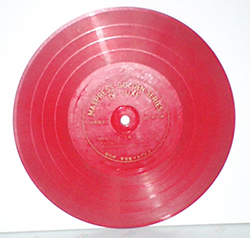
Y: The objects themselves have their own beauty, so it's all a matter of choice. It's just a matter of what you combine with what, and you don't really do much to the objects.
A: I think what Yagi said there links a little to what I said, but it seems like he has a lot of attention to detail.
Y: It's hard for me to put into words why slides are better than a normal video projector, so that's a tough question...
A: The tape work (Note: Sound Sphere, 2011) is also a very beautiful object.
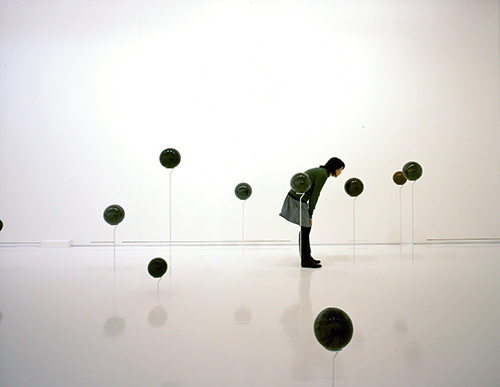
Y: But I didn't create the shape, and a sphere is a sphere. I think you probably wouldn't notice much difference between a bowling ball and a sphere. When it comes to whether it's perceived as beautiful, I feel like it doesn't have much meaning unless it's connected to the act of doing something. Earlier, when I said that something simply looks good, I meant that the finished product is based on a certain mechanism and that this shape is beautiful, so I think it's probably impossible to compete on form alone without considering functionality.
A: I feel like I'm really connected to it.
Y: Maybe it's a design-like editing perspective? For example, how to space things out, how much white space to use, etc. It's a matter of how you present it, but if you look at the thing you put out by itself...
For example, in the work that uses an umbrella pattern (Note: "Rainyday Music" 2005), the umbrella pattern is not particularly special, but somehow the shape looks really beautiful...

A: So it is connected to how you create your work that it appears that way.
Y: Yes, I do pay a lot of attention to the final finishing touches. For example, how the player of the ball device looks, or how many millimeters the wooden frame other than the aluminum sticks out from the edge. When creating a work, isn't framing very important? If anything, I'm more interested in the frame than the contents, and I find it more fun to think about how thick and deep the frame is than to create the work itself, and I think I like directing and editing it more than the work itself. I think that's probably based on what I've studied.
■Finally, please give a message to the visitors who will come to see the Off the Record exhibition.
Y: That's really difficult, isn't it? Of course, I want a lot of people to see my work, but that may be for political or economic reasons. If you ask me if artists create works because they want people to see them, I don't think that's the case.
A: LOL!
Y : From the organizer's point of view, attracting visitors to an exhibition is very important, isn't it? But don't artists have very little desire to have people come and see their work? I personally feel very embarrassed when my acquaintances look at the things I've made...
A: But I really do feel that way.
Y: So even if someone says to me, "I'm sorry I couldn't come to the exhibition," I'll just say, "It's okay, it's okay." So I can't say, "Why didn't you come and see it?" And yet, I get angry when someone stands me up for a drinking party...
A: But for me it's about half and half. Well, I do feel a bit embarrassed, but I guess the main thing is that I want to see it.
Y: I agree. So, I want the people I work with to be happy.
A: That's right.
Y: So I think that the society I have in my mind has not yet expanded beyond that, and there is still a long way to go.
A: But as Mr. Yagi said earlier, I kind of end up saying things like, "Please come to the exhibition"... (laughs)
Y: But if I'm going to do it, I want to show interesting things, and of course I want people to come, look, and be happy. My request to the visitors who come to my exhibition is that they come to the exhibition, relate it to their own lives, and think about something. I don't think art is useless. I think it can be useful in everyday life. But I feel like art is something that you can't use well unless you think about it properly. So, rather than just looking at it and having fun and going home for a moment, I think it's important to think about what it was like after you've seen the exhibition, even more than the people who made it. That's why art is a study.
A: Besides the exhibition, there will be readings, music, and performances, so I'm looking forward to those too. Also, it seems like they'll be making a good catalogue... I'd be happy if people could enjoy those as well.
Y: The catalogue will remain, but the exhibition will no longer be available to view once it has finished, so in that sense I hope people don't miss out on the opportunity to see an interesting exhibit.
